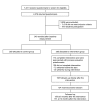Feasibility of a cognitive behavioural group intervention to reduce fear of falling and associated avoidance of activity in community-living older people: a process evaluation
- PMID: 17900336
- PMCID: PMC2194766
- DOI: 10.1186/1472-6963-7-156
Feasibility of a cognitive behavioural group intervention to reduce fear of falling and associated avoidance of activity in community-living older people: a process evaluation
Abstract
Background: Fear of falling and associated avoidance of activity are common among older people and may have negative consequences in terms of functional decline, quality of life and institutionalisation. We evaluated the effects of a cognitive behavioural group intervention to reduce fear of falling and associated avoidance of activity among older persons. This intervention showed favourable effects on fear of falling, avoidance of activity, daily activity, and several secondary outcomes. The aim of the present study is to assess the feasibility of this cognitive behavioural group intervention for participants and facilitators.
Methods: The intervention consisted of eight weekly group sessions lasting two hours each and a booster session after six months. Self-administered questionnaires, registration forms and interviews were used to collect data from participants (n = 168) and facilitators (n = 6) on the extent to which the intervention was performed according to protocol, participant attendance, participant adherence, and participants' and facilitators' opinion of the intervention. Quantitative data from the questionnaires and registration forms were analysed by means of descriptive statistics. Qualitative data were categorised based on matching contents of the answers.
Results: Facilitators reported no major protocol deviations. Twenty-six percent of the participants withdrew before the start of the programme. Of the persons who started the programme, 84% actually completed it. The participants reported their adherence as good, but facilitators had a less favourable opinion of this. The majority of participants still reported substantial benefits from the programme after six and twelve months of follow-up (71% and 61% respectively). Both participants and facilitators provided suggestions for improvement of the intervention.
Conclusion: Results of this study show that the current cognitive behavioural group intervention is feasible for both participants and facilitators and fits in well with regular care. Minor refinement of the intervention, however, is warranted to further improve intervention effectiveness and efficiency. Based on these positive findings, we recommend implementing a refined version of this effective and feasible intervention in regular care.
Trial registration: ISRCTN43792817.
Figures
References
-
- Tinetti ME, Speechley M, Ginter SF. Risk factors for falls among elderly persons living in the community. N Engl J Med. 1988;319:1701–1707. - PubMed
-
- Howland J, Lachman ME, Peterson EW, Cote J, Kasten L, Jette A. Covariates of fear of falling and associated activity curtailment. Gerontologist. 1998;38:549–555. - PubMed
Publication types
MeSH terms
Associated data
LinkOut - more resources
Full Text Sources
Medical


